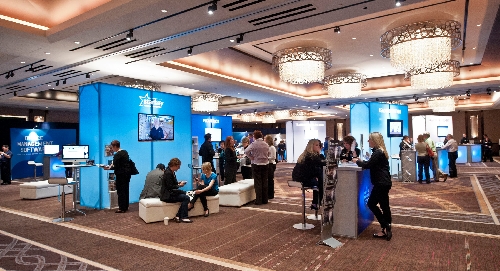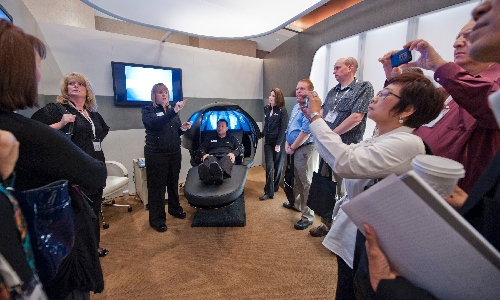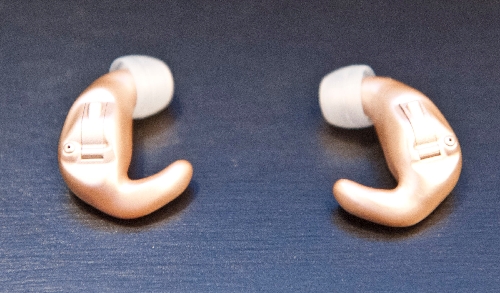Experts at Las Vegas convention say technology improves hearing aids





There’s an old joke in the auditory industry that illustrates the public relations problems — and the functional issues — related to hearing aids.
It starts with a man telling his friend, "I just got new hearing aids."
The friend says, "Oh? What kind are they?"
The man looks at his watch and answers: "It’s 3 o’clock."
Funny if you have perfect hearing. Not so funny if you’ve been in that guy’s shoes. And it’s downright disappointing if you are Brent Edwards, vice president for research at Starkey Laboratories Inc.
Starkey, the largest maker of hearing devices in the United States, held its innovation expo at The Cosmopolitan of Las Vegas last week. More than 3,000 audiologists and other hearing experts from across the country gathered to talk about the latest in hearing aids and what’s on the horizon.
There was a time when that joke wasn’t far from the truth and you may have had better results using an ear trumpet than a hearing aid. But those days are gone, Edwards says. Still, that news hasn’t filtered out into a public that could benefit from the latest hearing aid technology.
While hearing aids have grown more effective, Edwards says, the negative reputation lingers.
The good news is that hearing aids are smaller and better than ever. They’re so small that they are almost undetectable when worn in the ear. They also can help people hear better, understand speech more clearly and mask sounds such as ringing or buzzing.
Wireless technology, the same that is used in Bluetooth devices, has enabled manufacturers to address two of the biggest problems people encounter when using hearing aids: talking on the phone and watching television, Edwards says. The wireless technology allows sound to be streamed right to the hearing aid.
"This has been an evolution," says Jerry Ruzicka , president of Starkey. "Hearing aids were always analog devices. About a decade ago we started introducing digital. After that, we were able to take the next step, which was introduce software that could (program) hearing aids. Now we’ve taken the next step, which is to put these radios in each hearing aid."
There also have been advances in directional microphones, which are inside hearing aids and amplify sound. One of the biggest obstacles for hearing-aid wearers is communicating in a noisy environment, Edwards says. "That’s a huge challenge."
These new microphones add three decibels, which translates into almost a 45 percent improvement in a wearer’s ability to understand words.
Despite these advances, the average age of a person who buys a hearing aid is 69, Edwards says.
One would think that age would decrease as baby boomers age. In fact, boomers have been a driving force behind some of the developments in high-tech hearing, experts say. But there’s still a resistance to hearing aids that has been difficult to overcome.
Cost may be a problem. Most insurance companies don’t cover the cost of the devices, which can range from $1,000 to $4,000 each.
Deeply ingrained stigmas may be at play, too, Edwards says. If people think they are perceived as weak for needing hearing aids, they may be less likely to wear them. Also, if they feel like the hearing aids don’t help, they won’t wear them.
"There’s a fallacy that people expect hearing aids to give the same level of improvement that eyeglasses do to vision," Edwards says.
And that’s not true. There are two kinds of hearing loss: conductive, which is the ossification of the inner ear anatomy, and sensory neural. Hearing aids and surgery can almost perfectly overcome conductive hearing loss.
Most hearing loss is sensory neural, caused by noise or aging. A hearing aid can help restore some hearing in those cases, Edwards says, but it won’t be perfect.
Hearing loss can affect a person’s life in more ways than one, says Loleata Wigall , audiologist who attended the expo last week. She owns a private practice in Massachusetts.
People who are losing their hearing start withdrawing from life, Wigall says.
"They sometimes think other people are talking about them. They misunderstand conversations, thinking they got it right and they didn’t," Wigall says. "This can cause conflict. I think it can really affect family relationships. It can cause problems between child and parent and spouses. And it can come into play at work, too."
Even though more physicians are referring patients to get hearing tests, the majority of those who come to see Wigall did so at the insistence of their families.
Research has shown that hearing loss causes increased mental effort and distress because the brain has to work harder to understand sounds. In 2005, Brandeis University researchers found that people who suffer a hearing loss may also have poor memories. The belief is that, though they hear the information, the brain becomes taxed because it has to work harder to figure out what is speech and what is noise, Edwards says.
"You get really tired because you’re straining to hear," Wigall says. "I tell people all the time, ‘Don’t be surprised if you have more energy after you get hearing aids.’ "
People start losing their hearing at age 21, Wigall says. Baby boomers are losing their hearing faster than their parents did, mainly because we live in a noisy world, she adds. Music concerts, vacuum cleaners, anything that is so loud you have to raise your voice to be heard, can damage your hearing.
Also, diabetics are at a higher risk of hearing loss because of poor circulation. People who have had certain diseases or even taken certain medications, such as antibiotics, can be at a higher risk of losing their hearing. That includes people who received chemotherapy, Wigall notes.
Now, she counsels people to prevent hearing loss. Carry earplugs and use them. Turn the radio and television down.
Most importantly, she says, don’t be afraid to get your hearing checked.
"We take hearing for granted," she says. "Often, it’s so gradual, you don’t even notice you’re not hearing. But the rest of your family notices."
Contact reporter Sonya Padgett at spadgett@reviewjournal.com or 702-380-4564. Follow @StripSonya on Twitter.












